

Manual técnico para Rotación de Cultivos - InfoAgronomo. Secretario designado de Agricultura trabajará “de sol a sol” para impulsar al sector agroindustrial - El Nuevo Día. Pedacito de tierra. Oconuco Zuimaco.
Using Geospatial Technologies to Map and Track Food Supply Chains - GIS Lounge. The recent COVID-19 pandemic has highlighted that global food supply chains are vulnerable to disruption, potentially causing food shortages in many regions.
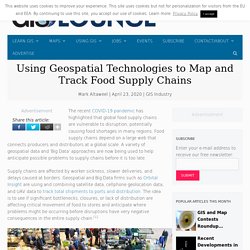
Food supply chains depend on a large web that connects producers and distributors at a global scale. A variety of geospatial data and ‘Big Data’ approaches are now being used to help anticipate possible problems to supply chains before it is too late. Supply chains are affected by worker sickness, slower deliveries, and delays caused at borders.
Geospatial and Big Data firms such as Orbital Insight are using and combining satellite data, cellphone geolocation data, and UAV data to track total shipments to ports and distribution. The idea is to see if significant bottlenecks, closures, or lack of distribution are affecting critical movement of food to stores and anticipate where problems might be occurring before disruptions have very negative consequences in the entire supply chain.[1] La inseguridad de la tenencia de la tierra - Center for Community Land Trust Innovation. Durante mucho tiempo, miles de personas de bajos ingresos en América Latina y el Caribe han ocupado terrenos urbanos y rurales, o han utilizado sus recursos naturales, incluidos cuerpos de agua, bosques, praderas y campos cultivables, sin tener el derecho oficial de hacerlo o sin que sus Gobiernos respeten los derechos registrados.
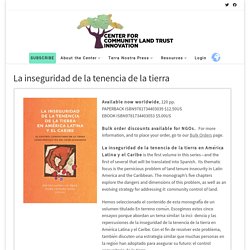
Viven en hogares que posiblemente fueron construidos, rehabilitados y ocupados por sus familias durante varias generaciones, pero estos están situados en solares de los que podrían desalojarlos algún día. Dependen de cuencas hidrográficas, bosques o tierras agrícolas para su sustento, pero es posible que algún día pierdan el acceso a los recursos que utilizan. En muchos de los casos, su tenencia es informal e insegura.
El desplazamiento es una amenaza siempre presente. CEER and PRNC Publications for Download. ▷ Libros de historia ~ Descarga Gratis ! Food and Agriculture Organization of the United Nations. The State of Food Insecurity in the World 2014 presents updated estimates of undernourishment and progress towards the Millennium Development Goal (MDG) and World Food Summit (WFS) hunger targets.
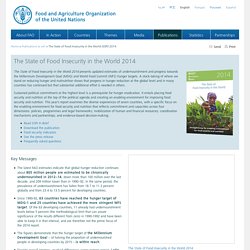
A stock-taking of where we stand on reducing hunger and malnutrition shows that progress in hunger reduction at the global level and in many countries has continued but that substantial additional effort is needed in others. Sustained political commitment at the highest level is a prerequisite for hunger eradication. Destinarán 16 millones en Puerto Rico al desarrollo de la industria agrícola. El gobernador Ricardo Rosselló Nevares anunció hoy junto al secretario del Departamento de Desarrollo Económico y Comercio (DDEC), Manuel A.
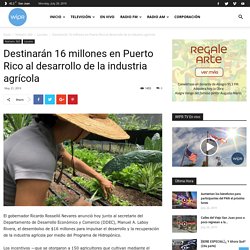
Agroecología como instrumento de cambio. El pasado 15 de marzo, los jóvenes del mundo tomaban las calles y las plazas al margen de organizaciones y partidos políticos.

Ciento cinco países se sumaban a la Huelga por el Cambio climático. El manifiesto de l@s jóvenes españoles empezaba hablando de los derechos fundamentales de las personas. What’s the Right Way to Regulate Gene-Edited Crops? - leapsmag. Kenneth Miller show profile In the next few decades, humanity faces its biggest food crisis since the invention of the plow.
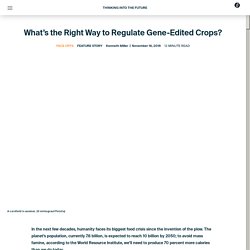
The planet’s population, currently 7.6 billion, is expected to reach 10 billion by 2050; to avoid mass famine, according to the World Resource Institute, we’ll need to produce 70 percent more calories than we do today. Imagine that a cheap, easy-to-use, and rapidly deployable technology could make crops more fertile and strengthen their resistance to threats. Meanwhile, climate change will bring intensifying assaults by heat, drought, storms, pests, and weeds, depressing farm yields around the globe.
So here’s a thought experiment: Imagine that a cheap, easy-to-use, and rapidly deployable technology could make crops more fertile and strengthen their resistance to these looming threats. Finally, imagine that crops bred with the aid of this tool might carry dangers. In fact, this technology does exist, though its use remains mostly experimental. The U.S. Elnuevodia. Environmental Insights Explorer - Google. New autonomous farm wants to produce food without human workers. Iron Ox isn’t like most robotics companies.
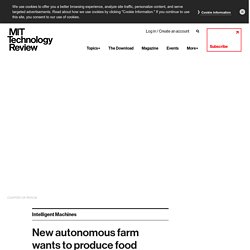
Instead of trying to flog you its technology, it wants to sell you food. As the firm’s cofounder Brandon Alexander puts it: “We are a farm and will always be a farm.” But it’s no ordinary farm. For starters, the company’s 15 human employees share their work space with robots who quietly go about the business of tending rows and rows of leafy greens. Today Iron Ox is opening its first production facility in San Carlos, near San Francisco. Iron Ox isn’t selling any of the food it produces just yet (it is still in talks with a number of local restaurants and grocers).
The farm’s non-lettuce-consuming staff consists of a series of robotic arms and movers. At first, making sure these different machines worked together was tricky. So Iron Ox has developed software—nicknamed “The Brain”—to get them to collaborate. Sign up for Clocking In A daily look at the workplace of the future But why go to the trouble of automating farming at all?
Data-driven agricultural decisions and insights to maximize every acre. How machine learning and sensors are helping farmers boost yields. Agriculture is always modernizing, but most farmers struggle to collect data that’s useful—or to analyze it in useful ways.
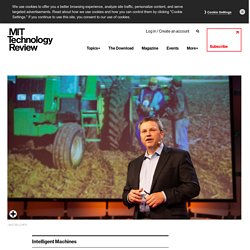
That’s changing: emerging tools for data collection and analysis are helping boost yields and make farming more sustainable, according to Sam Eathington, chief science officer at the Climate Corporation. In the next five to 10 years, “we’re going to see an explosion of sensors and collection of data from the farm,” Eathington said during his talk at MIT Technology Review’s EmTech conference today.
The Climate Corporation—originally founded in 2006 by a pair of former Google employees and now owned by German chemical giant Bayer—has developed tools to gather information from a variety of sources, including sensors on farming equipment as well as in the field. The data from these disparate sensors is then analyzed in the cloud. Fish and Wildlife Service. Fukushima’s nuclear signature found in California wine. Throughout the 1950s, the US, the Soviet Union, and others tested thermonuclear weapons in the Earth’s atmosphere.
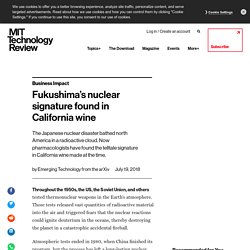
Those tests released vast quantities of radioactive material into the air and triggered fears that the nuclear reactions could ignite deuterium in the oceans, thereby destroying the planet in a catastrophic accidental fireball. Atmospheric tests ended in 1980, when China finished its program, but the process has left a long-lasting nuclear signature on the planet.
One of the most obvious signatures is cesium-137, a radioactive by-product of the fission of uranium-235. After release into the atmosphere, cesium-137 was swept around the world and found its way into the food supply in trace quantities. Such an addition is rarely welcomed. The technique immediately became a useful weapon in the fight against wine fraud—labeling young wines as older vintages to inflate their price. Cesium-137, on the other hand, allows noninvasive testing because it is radioactive. Treesearch - scientific articles written or published by the U.S. Forest Service. Gtr so051. IITF - Home. New publication from the Institute in collaboration with El Yunque National Forest.
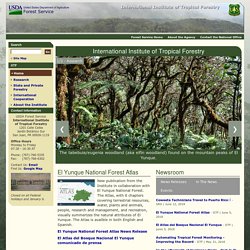
The Atlas, with 6 chapters covering terrestrial resources, water, plants and animals, people, research and management, and recreation, visually summerizes the natural attributes of El Yunque. The Atlas is availble in both English and Spanish. El Yunque National Forest Atlas News Release.
BirdsCaribbean. Books – Association Les Fruits de Mer. Les Fruits de Mer has produced a number of books about wildlife and ecology, both in print editions and as downloadable ebooks. All of our books are available for free on this page. eBooks Pond Life: Reflections If you like your ecosystems wet and wild, then you will love Pond Life: Reflections. Each chapter explores a different view into these ever-changing wild spaces. Caribbean Curiosities: Native Nature St. Caribbean Curiosities: Island of Change From prehistoric times to the present day, one of the most important ways humans have impacted St. HUCE. Bosques de Puerto Rico administrados por el DRNA para acampar. Ecology, Geography, and Agriculture — Biogeographic Research.
CFMC INDEX. Asignación para la conservación y el manejo de pesca. Corredor ecológico del Noreste. La Reserva Natural Corredor Ecológico del Noreste (CEN) se refiere a una zona designada como una reserva natural protegida ubicada en la costa noreste de Puerto Rico, entre los municipios de Luquillo y Fajardo. En concreto, los terrenos que componen el CEN están situados entre la plaza del pueblo de Luquillo al oeste y el balneario Seven Seas hacia el este, está delimitada por la ruta PR # 3 hacia el sur y el Océano Atlántico al norte. Fue decretado como área protegida por el Gobernador de Puerto Rico Aníbal S.